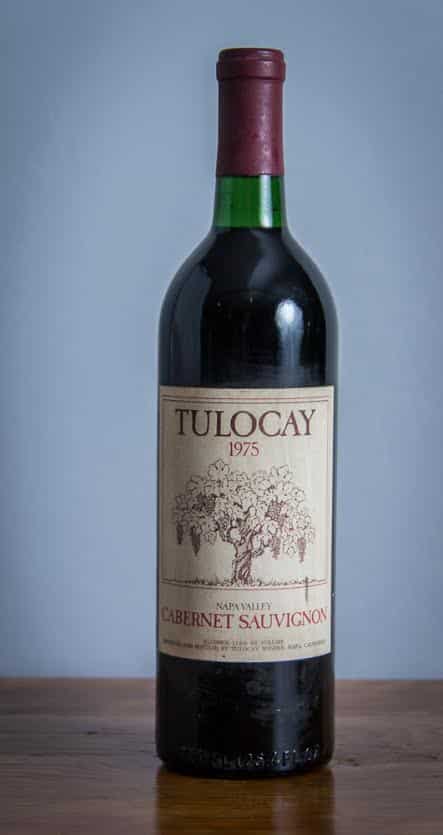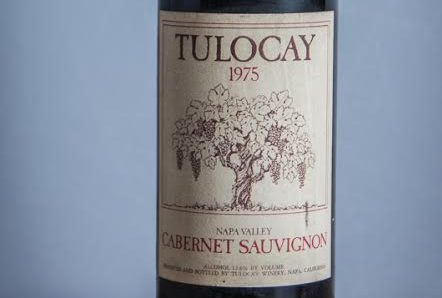“Drink wine, and you will sleep well. Sleep, and you will not sin. Avoid sin, and you will be saved. Ergo, drink wine and be saved.”
—Medieval German saying*
Like most of the “odd bottles” about which I write, I had only one 1975 Tulocay Cabernet Sauvignon. I bought it decades ago, soon after it had arrived at Rosenthal Wine Merchants, a small wine store on Manhattan’s East Side. The shop is now gone, but its owner, Neal Rosenthal, continues to be one of America’s finest importers and distributors of wine (as well as of specialty food products).
Rosenthal closed his fledgling store for three weeks in August, 1979, and went with his partner, Kerry Madigan, to Napa Valley to begin their direct-buying program. As he said recently, “We had the good fortune of stumbling upon Bill Cadman and his Tulocay winery located on Coombsville Road in Napa. We bought this still stunning 1975 Cabernet.”
Bill Cadman had founded Tulocay in 1974, when he was thirty years old. It is one of the oldest Napa wineries; it’s also one of the smallest.
The winery’s amusing and informative website says proudly that, since its first vintage, “Tulocay has been in the derrière-garde of the wine industry.”
The website instructs, forthrightly, those looking for White Zinfandel, mass-produced Merlot, or sweet, fruity Chardonnay to “go away!”
Cadman makes wines today as he did from the beginning, eschewing what he calls “the same so-called international style” and using “traditional methods that reflect the character of the individual vineyard as expressed by the winemaker.” The wines are bottled unfined and unfiltered, throw sediment from an early age, and are meant to age and to be aged.
I can attest to the Cabernet’s ability to age. The 1975 was Tulocay’s first vintage. According to Cadman, it was a very good vintage, for which he considers himself lucky. The harvest was late, ending in November. Cadman kept this wine in barrels for almost two years and bottled it in August, 1977. It was two years later that Neal Rosenthal arrived on Coombsville Road and bought the wine.
Commbsville received its AVA (American Viticulture Area designation) only in 2011. On its website, it describes itself as a quiet corner of southeast Napa Valley, and though only four miles from the town of Napa, unrecognized by most people who pass through it and yet “poised to be acknowledged as the next great Napa Valley sub-appellation.” I don’t doubt it. I am eager to visit it and to accept Bill Cadman’s invitation (you have one too) to visit Tulocay.
He’s a great vinous storyteller, infectious in an enthusiasm, for wine and its creation, that gives the impression he is bubbling over and has finally achieved the ability to deliver wine right through the telephone.
Cadman’s memory seems prodigious. Neal Rosenthal had written to me that this 1975 Napa Valley Cabernet came from the Egan Vineyard near the Stag’s Leap viticulture zone (all Tulocay grapes are purchased and all its wines are made from grapes grown in a single vineyard). I asked Bill Cadman if this was true, and, if it was, why the label did not, as future bottlings would, identify the grapes as having come from Egan Vineyard.
This is how Bill Cadman answered that question: For his very first attempt to produce a Cabernet Sauvignon, he was promised Cab grapes from a vineyard owned by Bill and Peggy Weeks, but Bill and Peggy sold the last grapes just before Cadman was to pick them up. But they did tell Cadman of another Silverado Trail vineyard, owned by Van Moller, who indeed sold Cadman the grapes that were made into this 1975 Cabernet. Van Moller later sold this vineyard to Robert Egan, and Cadman continued to buy grapes from this same vineyard and eventually to put its name on his labels.
So Neal Rosenthal was correct, if prematurely: the grapes came from the Egan Vineyard, but it was before this vineyard was called the Egan Vineyard.
As for the wine itself, at forty years of age it was still red to the rim and sufficiently un-Cabernet-like to be classically Cabernet. Which is to say this wine was rich with the flavor of the fruit that settled and occupied the throat and encouraged one not to swallow, because to have the wine leave one’s mouth seemed like a sacrifice too great to make. Rich, yes, but not ostentatious.
Like other odd bottles, I kept it around and tasted it for as long as it held up. (Always, once opened, stored in the refrigerator and warmed up to room temperature from there.) It didn’t last as long as other old, odd bottles, but it still took four days to fade, which means that if you were to come upon a bottle of this wine in this vintage, and you were to wait ten years from now to open it, when it’s fifty years old, you will be a very happy, lucky person.
If you want to buy Bill Cadman’s present vintages, the best way to do that is to visit the winery or join its wine club, which, the website promises, will give you “the smug feeling of belonging to Napa Valley’s least exclusive wine club.” ![]()
“A cask of wine works more miracles than a church full of saints.”—Italian proverb*
* These quotations are from among others on the Tulocay website—another reason to visit it.

First published October 2015
